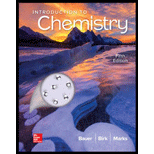
(a)
Interpretation:
A balanced net ionic equation for the given reaction is to be written with physical state of each substance.
(a)
Explanation of Solution
Except for chromium (III) hydroxide (Cr(OH)3), all other substances in the given reaction are electrolytes. The molecular equation of the given reaction with the physical state of each substance is as follows:
In an ionic equation, the electrolytes are written as separated ions. The ionic equation of the given reaction is as follows:
Potassium ion (Na+) and sulfate ion are spectator ions in the given reaction and are removed to get the net ionic equation. The net ionic equation is as follows:
Both the chromium ion and hydroxyl ion are balanced by multiplying the appropriate number. The balanced net ionic equation is as follows:
(b)
Interpretation:
A balanced net ionic equation for the given reaction is to be written with physical state of each substance.
(b)
Explanation of Solution
Lead (II) chloride (PbCl2) and lead (II) chromate (PbCrO4) are non-electrolytes whereas potassium chloride (KCl) and potassium chromate (K2CrO4) are electrolytes. The molecular equation with the physical state of each substance is as follows:
The ionic equation of the above reaction is as follows:
As potassium ion is spectator ion, the net ionic equation is as follows:
The above equation is balanced by putting coefficient 2 in front of chloride ion. The balanced net ionic equation is as follows:
(c)
Interpretation:
A balanced net ionic equation for the given reaction is to be written with physical state of each substance.
(c)
Explanation of Solution
Except for sulfur dioxide (SO2) and water (H2O), all other substances in the given reaction areelectrolytes. The molecular equation for the given reaction is as follows:
The ionic equation is as follows:
As sodium and sulfate ion are spectator ions, the net ionic equation is as follows:
The above equation is already balanced.
Want to see more full solutions like this?
Chapter 5 Solutions
Introduction To Chemistry 5th Edition
- Name the following carbohydrates give both the systematic and common names. Don't forget to identify the Isomer.arrow_forwardWhat is the product of the reaction of XeF4 with H2O? Group of answer choices H2XeF2 H2XeF4 XeO3 H2XeOarrow_forwardWhile noble gas exerts the strongest London (dispersion) forces on neighboring atoms? Group of answer choices Xe Ar Kr Nearrow_forward
- Which of the following elements is corrosive to your skin due to that element breaking down C=C bonds? Group of answer choices fluorine iodine bromine chlorinearrow_forwardWhat the best source of sulfide to use on a small scale in the lab? Group of answer choices thiourea H2S NaHS Na2Sarrow_forwardWhich of the following statements about sulfur is FALSE? Group of answer choices H2S is the product of an oxygen-depleted ecosystem. In the acid mine drainage reaction, FeS2 is a product. One allotrope of sulfur has the formula S20. In the environment, bacterial oxidation can convert S2− to elemental S or SO42−.arrow_forward
 Chemistry: The Molecular ScienceChemistryISBN:9781285199047Author:John W. Moore, Conrad L. StanitskiPublisher:Cengage Learning
Chemistry: The Molecular ScienceChemistryISBN:9781285199047Author:John W. Moore, Conrad L. StanitskiPublisher:Cengage Learning General Chemistry - Standalone book (MindTap Cour...ChemistryISBN:9781305580343Author:Steven D. Gammon, Ebbing, Darrell Ebbing, Steven D., Darrell; Gammon, Darrell Ebbing; Steven D. Gammon, Darrell D.; Gammon, Ebbing; Steven D. Gammon; DarrellPublisher:Cengage Learning
General Chemistry - Standalone book (MindTap Cour...ChemistryISBN:9781305580343Author:Steven D. Gammon, Ebbing, Darrell Ebbing, Steven D., Darrell; Gammon, Darrell Ebbing; Steven D. Gammon, Darrell D.; Gammon, Ebbing; Steven D. Gammon; DarrellPublisher:Cengage Learning Chemistry & Chemical ReactivityChemistryISBN:9781337399074Author:John C. Kotz, Paul M. Treichel, John Townsend, David TreichelPublisher:Cengage Learning
Chemistry & Chemical ReactivityChemistryISBN:9781337399074Author:John C. Kotz, Paul M. Treichel, John Townsend, David TreichelPublisher:Cengage Learning Chemistry: Principles and PracticeChemistryISBN:9780534420123Author:Daniel L. Reger, Scott R. Goode, David W. Ball, Edward MercerPublisher:Cengage Learning
Chemistry: Principles and PracticeChemistryISBN:9780534420123Author:Daniel L. Reger, Scott R. Goode, David W. Ball, Edward MercerPublisher:Cengage Learning Introductory Chemistry: A FoundationChemistryISBN:9781337399425Author:Steven S. Zumdahl, Donald J. DeCostePublisher:Cengage Learning
Introductory Chemistry: A FoundationChemistryISBN:9781337399425Author:Steven S. Zumdahl, Donald J. DeCostePublisher:Cengage Learning Chemistry for Engineering StudentsChemistryISBN:9781337398909Author:Lawrence S. Brown, Tom HolmePublisher:Cengage Learning
Chemistry for Engineering StudentsChemistryISBN:9781337398909Author:Lawrence S. Brown, Tom HolmePublisher:Cengage Learning





